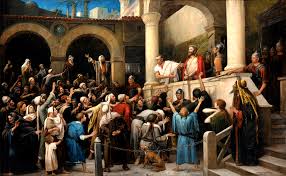
Burial

Having demonstrated that Jesus’ death was entirely in accordance with God’s purposes as revealed prophetically in the Old Testament, John goes on to show that his death moves Joseph of Arimathea and Nicodemus to open commitment as believers in Jesus as Messiah and Lord. He carefully notes that Joseph had been only a secret believer because of his fear of the Jewish leaders and that Nicodemus was the one who had come to Jesus secretly by night. But now they fearlessly and openly ask Pilate for Jesus’ body and bury him in the proper Jewish way with spices and wrapped in linen cloths (19.38-42).
In our teaching and preaching it is easy to omit mention of Jesus’ burial, but the Christian creeds rightly confess that Jesus was “crucified, dead and buried”. Some of us will have suffered bereavement with the death of someone we love and then have stood around the grave as the coffin has been lowered into the ground. The cold reality of the grave can bring a sense of utter desolation and lonely hopelessness. How amazing that Jesus, the King of kings, totally laid aside his glory and went even to the grave for us! He knows and understands. He has been there himself.

Resurrection
Normally in the New Testament passive tenses are used with reference to the resurrection of Jesus. He did not rise again by his own divine power. He had indeed laid aside his glory and was truly dead. His burial underlines the reality that Jesus seemed absolutely cold and finished. There seemed to be no future for those who loved and believed in him. But then God the Father stepped into this picture of hopeless death and raised that cold body to new life. The glory of this defies mere words and sends a shiver of excitement down the spine!
If Jesus had raised himself, we would of course have worshipped him and gloried in him. But we might also have felt our own hopeless weakness, for we could never be like him and raise ourselves to new life. We know the frustration of trying to pull ourselves up by our own boot strings! But wonderfully our heavenly Father observed the cold body of Jesus and stepped into the situation – and Jesus was raised from the dead. So God can do it also for us despite our spiritual coldness and helplessness.

Witnesses of the Resurrection
As soon as the end of Sabbath permitted it, Mary Magdalene went to the tomb. Finding it empty and the entry stone rolled away, she assumed that someone had removed the body. She ran to Peter and “the other disciple” (John himself?). Although John got to the tomb first, he was hesitant to go into it. On the other hand, Peter went straight in. John’s account fits their characters so well! Finally John also dares to go into the grave and he sees the linen cloths folded in place – but no body! In simple but impressive words he states, “and he saw and he believed” (20.8). His eyes were opened to the reality of the resurrection. Later when Thomas meets the risen Jesus and believes, Jesus says to him “Because you have seen me, you have believed; blessed are those who have not seen and yet have believed” (20.29). In God’s grace he has allowed us too the blessing of believing without necessarily having any visible experience to prove his resurrection.
The account of Mary meeting the risen Jesus is so moving! He simply calls her by name “Mary”. This very personal note makes her realise that the person before her is not just the gardener. It is the risen Jesus. John here uses the common word “says” – Jesus says to her “Mary” and she says to him “Rabboni/Teacher”. Very intimate and homely.
We may note that John feels the need to translate the Aramaic “Rabboni”, evidently assuming that at least some of his readers will not understand Aramaic. He is clearly not writing just with his fellow-Jews in mind, but also for a wider Gentile audience. Of course this fits the whole thrust of his Gospel. He is demonstrating that the good news of the resurrected Jesus is for all people, both Jew and Gentile.

Jesus says to Mary that she should go to “my brothers” and say to them that he is returning “to my Father and your Father and my God and your God”. Overlooking the disciples’ abysmal failure at the time of his trial and crucifixion, Jesus still calls them “my brothers”. What grace! How wonderful too that Jesus calls us all his brothers/sisters! His Father is also our Father. His God is also our God. We are one with Jesus himself in these deeply intimate relationships.
In telling Mary to go and say that he is returning to his Father Jesus uses common words which have no special significance. But John goes on to say that Mary then “proclaimed” to the disciples her amazing experience: “I have seen the Lord” and he had said these things to her (20.18). In Matthew’s Gospel too Jesus instructs the two women who were the first to witness the resurrection that they should ‘go and proclaim’ (Matt.28.10). This contrasts with the fact that the angel had merely told them to “go quickly and tell” (Matt.28.7). The verb “proclaim” has the same basic root as the word for “Gospel” and implies preaching. So Mary was the first preacher of the resurrection, the heart of the gospel. But even if women were the first Christians to preach the good news of Jesus, we hasten to add that it is still allowable that men may also preach!
Many of the verbs in John’s description of these resurrection events are in the dramatic present tense e.g. “she sees Jesus . . . and Jesus says to her” (John 20.14,15). John was writing many years later, but he was evidently re-living these amazing life-changing experiences. Now we today are reading his accounts of Jesus’ resurrection. Let us also enter into John’s feelings of excitement – and believe!











Recent Comments